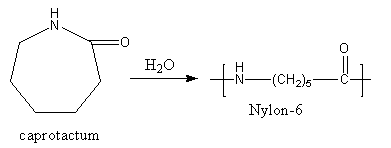
Nylon-$6$ is made by caprolactam which is formed from--
A. Cyclohexanone and hydroxyl amino
B. Cyclohexanone and hydrazine
C. benzophenone and hydrazine
D. benzophenone and hydroxylamine
Answer
542.7k+ views
Hint: To answer this question we should know the structure of nylon-$6$ and caprolactam so, we can take an idea to form the structure about its reactant. The caprolactam is a seven membered ring having six carbon and one nitrogen. It has one carbonyl group and one secondary amine group in the ring.
Complete step-by-step answer:When a large number of molecules join in a continuous way to form a long structure, the structure is known as a polymer. In a polymer, a molecule or unit repeats again, and again that’s why the formed structure is known as a polymer because the word ‘poly‘ means many, and ‘mer’ means units. The units which repeat are known as repeating units or monomers.
Cyclohexanone and hydroxyl amino react to give caprolactam. The formation of caprolactam is shown as follows:
Cyclohexanone reacts with hydroxyl amino so, a water molecule removes forming a C=N double
bond. Then in acidic medium caprolactam forms.

The caprolactam is allowed to react at high temperatures in a vacuum. The water is used as the initiator. The reaction is shown as follows:

So, nylon-$6$ is made by caprolactam which is formed from cyclohexanone and hydroxyl amino.
Therefore, option (A) Cyclohexanone and hydroxyl amino, is correct.
Note:Nylon-$6$ is formed by ring-opening polymerization. Nylon-$6$ and Nylon-$66$ , both are different polymers. Nylon-$6$ is formed by one type of monomer caprolactam. The Nylon-$66$ is formed by two types of repeating units, hexamethylenediamine, and adipic acid. The number $6$ represents the number of carbon atoms. The caprolactam has $6$ carbon atoms. Both monomers of Nylon- $66$ have $6$ carbon atoms.
Complete step-by-step answer:When a large number of molecules join in a continuous way to form a long structure, the structure is known as a polymer. In a polymer, a molecule or unit repeats again, and again that’s why the formed structure is known as a polymer because the word ‘poly‘ means many, and ‘mer’ means units. The units which repeat are known as repeating units or monomers.
Cyclohexanone and hydroxyl amino react to give caprolactam. The formation of caprolactam is shown as follows:
Cyclohexanone reacts with hydroxyl amino so, a water molecule removes forming a C=N double
bond. Then in acidic medium caprolactam forms.

The caprolactam is allowed to react at high temperatures in a vacuum. The water is used as the initiator. The reaction is shown as follows:

So, nylon-$6$ is made by caprolactam which is formed from cyclohexanone and hydroxyl amino.
Therefore, option (A) Cyclohexanone and hydroxyl amino, is correct.
Note:Nylon-$6$ is formed by ring-opening polymerization. Nylon-$6$ and Nylon-$66$ , both are different polymers. Nylon-$6$ is formed by one type of monomer caprolactam. The Nylon-$66$ is formed by two types of repeating units, hexamethylenediamine, and adipic acid. The number $6$ represents the number of carbon atoms. The caprolactam has $6$ carbon atoms. Both monomers of Nylon- $66$ have $6$ carbon atoms.
Recently Updated Pages
The number of solutions in x in 02pi for which sqrt class 12 maths CBSE

Write any two methods of preparation of phenol Give class 12 chemistry CBSE

Differentiate between action potential and resting class 12 biology CBSE

Two plane mirrors arranged at right angles to each class 12 physics CBSE

Which of the following molecules is are chiral A I class 12 chemistry CBSE

Name different types of neurons and give one function class 12 biology CBSE

Trending doubts
Which are the Top 10 Largest Countries of the World?

What are the major means of transport Explain each class 12 social science CBSE

Draw a labelled sketch of the human eye class 12 physics CBSE

Differentiate between insitu conservation and exsitu class 12 biology CBSE

The computer jargonwwww stands for Aworld wide web class 12 physics CBSE

State the principle of an ac generator and explain class 12 physics CBSE




